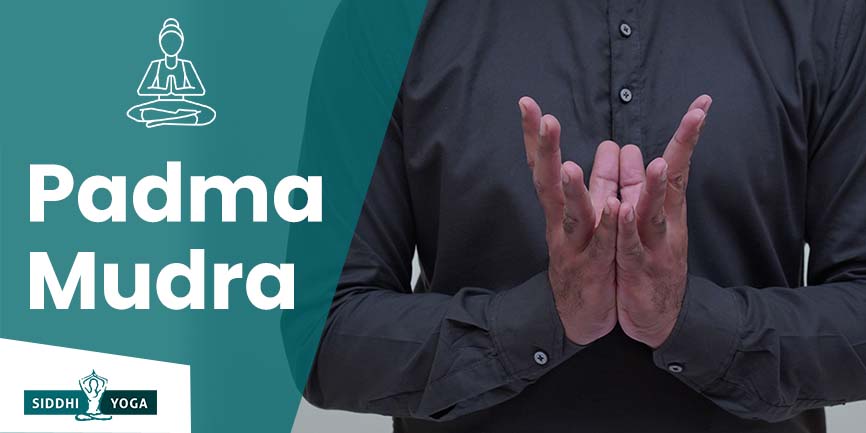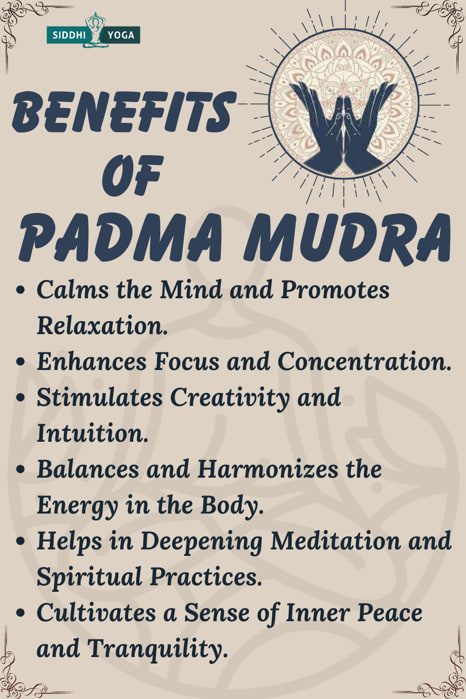
Discover the meaning of the Padma Mudra, its benefits, and how to do it yourself in this comprehensive guide.
Definition – What is Padma Mudra and its Meaning, References, and Mythology?
Padma Mudra is a type of Hasta Mudra (Hand gesture or seal). It is one such Mudra by practicing of which your mind will leave all the negativity & darkness behind. Padma Mudra is also known as the Lotus seal or Lotus hand gesture, as it resembles a lotus.
While practicing this, you can feel your heart is being opened to a new level. You feel emotionally well-balanced. You become open to new challenges and new experiences in life.
It is also related to the goddess Lakshmi, the goddess of fortune. So, if we practice this Mudra, we can achieve wealth, prosperity, and happiness. With happiness & prosperity comes a sense of satisfaction.
This Mudra helps to move from darkness to light. When negativity surrounds us, we find ourselves in complete darkness. If we practice this Mudra amidst such a state, it will lift our mood and bring us back to the light. Positive things will start to enter our lives.
So, practicing Padma Mudra creates a positive ambiance around the practitioner.
Most religions that have roots around the Indian subcontinent follow the same imagery and symbolism.
Lotus has a unique property in that it flourishes around the muddy place. Similarly, practicing this can alleviate certain Doshas (hurdles) from our lives.
Alternate Names of Padma Mudra
The Lotus seal or Lotus hand gesture.
How to Do Padma Mudra?
- Firstly, we will start by sitting in a comfortable meditative posture, for example, Lotus Pose (Padmasana) or Auspicious Pose (Swastikasana).
- Neck and spine comfortably erect.
- Entire awareness should be focused on the breath.
- Slowly and gently bring your palms close to the heart in Namaskar Mudra.
- Now, slowly and gently join your small fingers and thumbs together.
- Open all the remaining fingers just like the blossoming petals of a lotus.
- Keep the heels of your palms together.
- Slowly & comfortably close your eyes.
- Bring your awareness to the breath and breath as deeply as you can.
- Now, if you feel comfortable, you can also add om mantra chanting for deeper concentration.
Padma Mudra Benefits

- It activates Anahata Chakra, which brings joy, simplicity & satisfaction to our life.
- If you experience stress or anxiety, it is one of the ideal Mudrasthath that can help you build your practice. It calms the nervous system and re-establishes the much-needed balance.
- When our nervous system relaxes, it activates the rest and digestive response of our body. Once this response gets activated it improves our digestive system to a great extent. It improves the digestive system as well.
- It promotes purity of mind, body, & soul. As the lotus blossoms out of mud, it is a great epitome for those building themselves from scratch. Who work hard every day & achieve new heights with every passing day.
- It calms the mind and helps to maintain focus.
Padma Mudra Precautions and Contraindications
Similar to all other Mudra practices, it has no side effects.
However, there are a few things to consider:
- Do not firmly press your finger against each other. They should be slightly touching each other and not put excessive pressure.
When and how long to do Padma Mudra?
This Mudra can be practiced whenever you feel you are lacking focus. Especially those days when you feel negativity has surrounded you.
Morning is the ideal time to do any yoga or Mudra. In the morning, at this time during the daytime, our brain is at its best. So, you are more likely to be able to concentrate easily. Therefore, you should practice this Mudra from 4 am and 6 am to get the most effective outcomes.
If you are having difficulty with this during the morning, you can do this Mudra later in the evening too.
Practicing this Mudra for a minimum of 30-40 minutes daily is recommended. Whether you wish to complete it in one stretch or two threes that last between 10 and 15 minutes, it’s up to you. Based on research, the best way to practice an exercise for at least 20 minutes is to get the best benefits of that particular Mudra.
Breathing in Padma Mudra
You can practice various breathing techniques along with this Mudra. However, practicing Yogic breathing is encouraged.
Visualization in Padma Mudra
- Visualize that you are sitting on one large lotus.
- You are stable.
- You are receiving wisdom and prosperity from every direction.
Affirmation in Padma Mudra
While practicing this, Keep a positive intention. Start with:
“I am a ray of the sun who pierces through the darkness and lightens up the day.”
Conclusion
The Padma Mudra is a Mudra or gesture that is often used in yoga and meditation. It is said to have many benefits, including reducing stress and anxiety, improving sleep quality, boosting immunity, and more. If you’re interested in learning more about Mudras and how to use them effectively, consider enrolling in our Mudras Certification Course. In this course, you’ll learn all 108 Mudras and their benefits to incorporate them into your yoga practice or daily life.
Responses